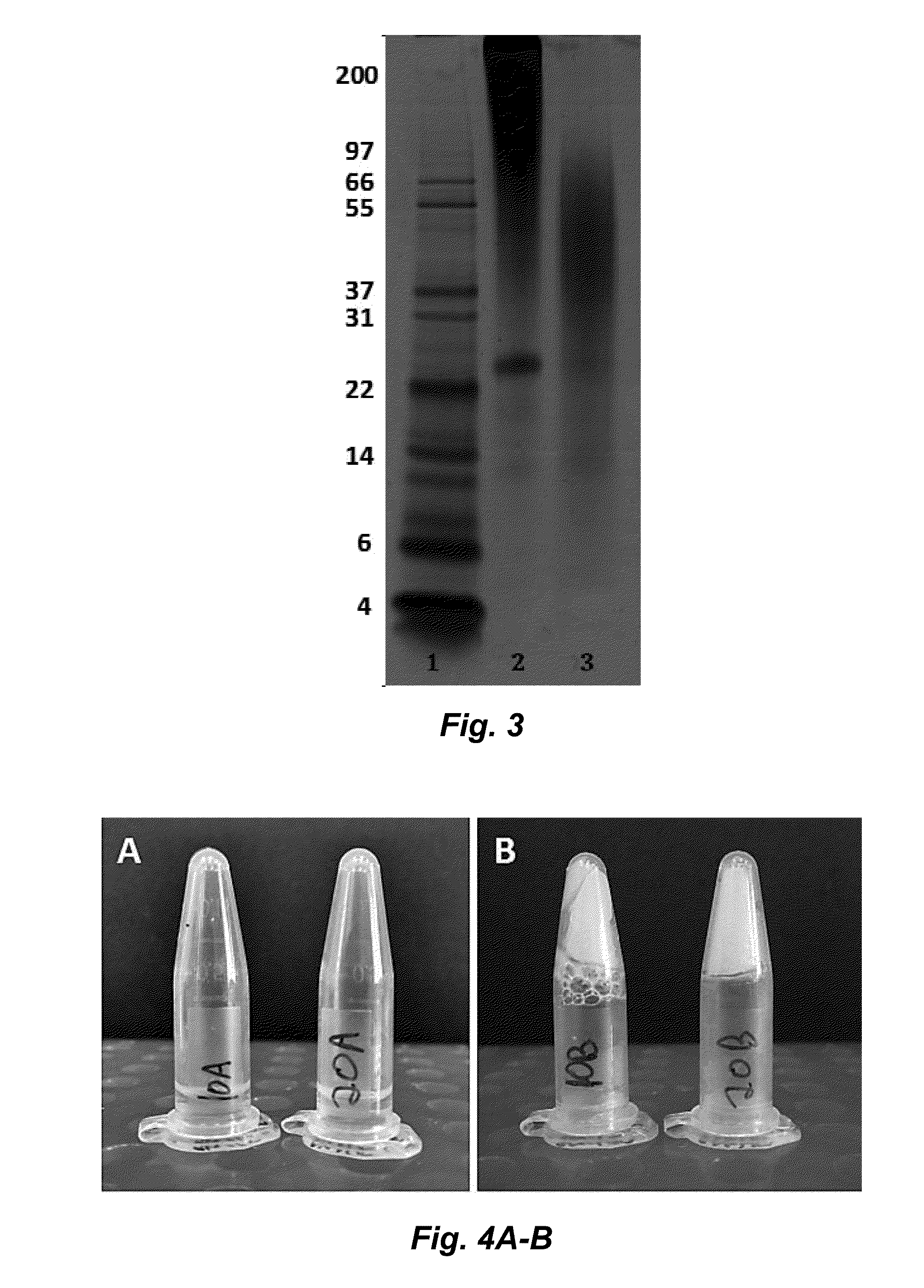Fibroin-derived protein composition
a technology of fibroin and composition, applied in the direction of drug composition, peptide/protein ingredient, peptide, etc., can solve the problems of limited material shelf life, limiting the application of the solution for aqueous solution-based applications, and relatively unstable silica fibroin protein solutions, etc., to achieve enhanced solubility and stability
- Summary
- Abstract
- Description
- Claims
- Application Information
AI Technical Summary
Benefits of technology
Problems solved by technology
Method used
Image
Examples
example 1
Silk-Derived Protein Preparation and the Lawrence Stability Test
[0115]Materials.
[0116]Silkworm cocoons were obtained from Tajima Shoji Co., Ltd., Japan. Lithium bromide (LiBr) was obtained from FMC Lithium, Inc., NC. An autoclave was obtained from Tuttnauer Ltd., NY. The 3,500 Da molecular-weight cutoff (MWCO) dialysis membranes were obtained from ThermoScientific, Inc., MA. An Oakton Bromide (Br−) double-junction ion-selective electrode was obtained from ISE, Oakton Instruments, IL.
[0117]Processing.
[0118]Two samples, SDP and prior art silk fibroin, were prepared as illustrated in FIG. 1. Briefly, SDP was produced by submerging pupae-free, cut silkworm cocoons (3-5 cuts / cocoon) into 95° C. heated, deionized water (diH2O) containing 0.3 wt % NaCO3 at 233 mL water / gram of cocoons. Cocoons were agitated in this solution for 75 minutes to dissolve sericin, thereby separating it from the silk fibers. The cocoons were subsequently washed four times in like dilutions of diH2O for 20 minute...
example 2
Silk-Derived Protein Molecular Weight Characterization
[0122]To evaluate the effect of processing on the molecular weight distribution of solubilized protein, SDP Solution and Prior Art Silk Fibroin Solution were subjected to polyacrylamide gel electrophoresis (PAGE), which separates proteins by molecular weight. Specifically, 15 μg of each sample was mixed with running buffer containing sodium dodecyl sulfate and dithiothreitol (Biorad Inc., CA) to remove any secondary folding structures and disulfide bonds, respectively. The mixtures were then heated to 70° C. for 5 minutes. The mixtures were loaded along with a 2.5-200 kDa molecular weight ladder (Life Technologies, CA) onto pre-cast, 4-12% polyacrylamide gradient gels containing Bis-Tris buffer salts (Life Technologies, CA), and then exposed to 120V electric field for 90 minutes on a BioRad PowerPac Power supply (BioRad Inc., CA). The gels were then removed and placed in Coomassie Blue stain for 12 hours to stain proteins, follow...
example 3
Silk-Derived Protein Stability Study
[0124]To further determine the functional impact of the autoclave process on the stability of the resulting SDP compared to the stability of prior art fibroin, the samples were analyzed using the methods of Wang et al. (Biomaterials 2008, 29(8):1054-1064) to mimic a well-characterized model of silk fibroin protein gelation. Volumes of both samples (0.5 mL, SDP and PASF) were added to 1.7 mL clear centrifuge tubes and were subjected to ultrasonication (20% amplitude, 10 Hz, 15 seconds). The clear tubes containing the solutions were then visually monitored for gel formation as a screen for gelation.
[0125]The SDP Solution samples failed to form gels, as shown in FIG. 4A. Even 3 months post-sonication, the SDP samples remained in solution and lacked protein aggregation as determined by visual inspection. The Prior Art Silk Fibroin Solution sample gelled rapidly (within 2 hours) following sonication. The resulting gelled Prior Art Silk Fibroin is shown...
PUM
| Property | Measurement | Unit |
|---|---|---|
| molecular weight | aaaaa | aaaaa |
| viscosity | aaaaa | aaaaa |
| viscosity | aaaaa | aaaaa |
Abstract
Description
Claims
Application Information
 Login to View More
Login to View More - R&D
- Intellectual Property
- Life Sciences
- Materials
- Tech Scout
- Unparalleled Data Quality
- Higher Quality Content
- 60% Fewer Hallucinations
Browse by: Latest US Patents, China's latest patents, Technical Efficacy Thesaurus, Application Domain, Technology Topic, Popular Technical Reports.
© 2025 PatSnap. All rights reserved.Legal|Privacy policy|Modern Slavery Act Transparency Statement|Sitemap|About US| Contact US: help@patsnap.com



